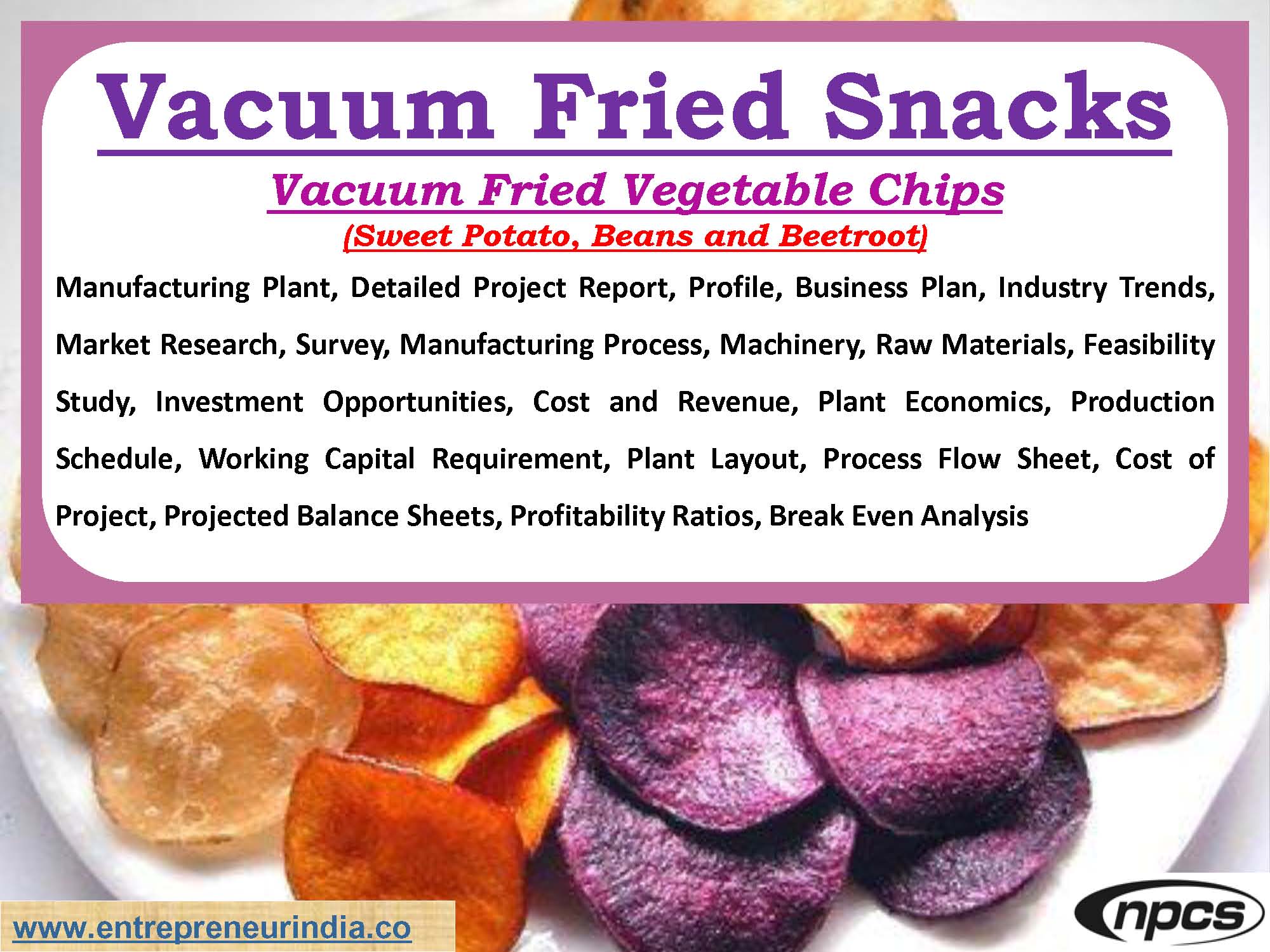
India’s snacking culture is evolving rapidly, with consumers now seeking healthier alternatives to deep-fried foods. One such rising trend is vacuum-fried snacks—chips made using low-temperature frying under vacuum to retain nutrients and flavor while using significantly less oil. The Vacuum-Fried Snacks Business is emerging as a profitable and modern food processing opportunity for startups and small manufacturers. Moreover, the unique selling point of these snacks lies in their crispiness, vibrant color, extended shelf life, and health appeal, making them a strong competitor to traditional fried products.
Vacuum-Fried Snacks Business | Chips Manufacturing Setup
Starting a Vacuum-Fried Snacks Business is a forward-looking investment in India’s food processing industry. From banana and jackfruit to beetroot and okra, vacuum frying transforms a wide range of fruits and vegetables into nutritious and tasty chips. As consumer demand shifts toward clean-label, non-GMO, and low-fat snacks, vacuum-fried products are gaining shelf space in supermarkets, health stores, and online platforms. Moreover, this segment is supported by government incentives under MSME and PMFME schemes, making it ideal for new entrepreneurs.
What Is Vacuum Frying?
Vacuum frying is an advanced method that involves frying food at low temperatures (80–120°C) under reduced pressure. This technique minimizes oil absorption and prevents oxidation, preserving the food’s natural color, texture, and nutrients.
Key benefits:
-
Up to 60% less oil than traditional frying
-
Retains original taste and color of raw material
-
Extends shelf life without added preservatives
-
Ideal for health-conscious and premium markets
-
Reduces acrylamide formation (a known carcinogen)
Moreover, vacuum frying is suitable for tropical fruits and vegetables that are sensitive to heat.
Read Also :How to Start Nail Factory
Best-Selling Vacuum-Fried Snack Products
India’s rich agricultural diversity allows year-round production of various vacuum-fried chips:
-
Banana chips (ripe and raw)
-
Sweet potato chips
-
Jackfruit chips
-
Beetroot and carrot chips
-
Okra (ladyfinger) chips
-
Apple and pineapple slices
-
Bitter gourd and yam chips
-
Mixed vegetable snack packs
Moreover, vacuum-fried snacks are gluten-free and suitable for vegan, keto, and diabetic diets.
Raw Material Procurement Strategy
To ensure quality and consistency in your Vacuum-Fried Snacks Business, source fresh, seasonal, and high-starch fruits and vegetables.
Sourcing tips:
-
Partner with local farmers or FPOs for direct supply
-
Choose organic or pesticide-free produce for premium branding
-
Set up cold storage for year-round availability
-
Focus on varieties that yield crispy textures after frying
Moreover, stable supply chains reduce production delays and pricing volatility.
Machinery and Setup Requirements
Setting up a vacuum-fried snacks unit involves specialized equipment:
-
Fruit/vegetable washer and peeler
-
Slicer (adjustable thickness)
-
Blancher (to preserve texture)
-
Vacuum fryer (main machine with oil heating system)
-
De-oiling unit or oil extractor
-
Cooling and drying conveyors
-
Seasoning and flavor mixing unit
-
Packaging line (form-fill-seal machine)
Capacity: A small-scale setup (50–100 kg/day) is ideal for pilot production. Medium to large-scale plants (200–500 kg/day) require advanced automation.
Moreover, cleanroom production areas are recommended to maintain food safety and hygiene standards.
Licensing and Compliance
Before starting your Vacuum-Fried Snacks Business, secure these essential registrations:
-
FSSAI License – Mandatory for food manufacturing
-
GST Registration – For tax and interstate sales
-
Udyam Registration – For MSME classification
-
Factory License – If employing more than 10 workers
-
Pollution Control NOC – For oil usage and waste management
Moreover, adhering to ISO 22000 or HACCP standards can enhance product credibility in export markets.
Investment and Profit Margin Analysis
Capital investment varies based on capacity and level of automation:
| Scale | Investment Range | Estimated Monthly Profit |
|---|---|---|
| Small (50–100 kg/day) | ?15 – ?25 lakhs | ?60,000 – ?1.5 lakhs |
| Medium (200–300 kg/day) | ?30 – ?60 lakhs | ?2 – ?4 lakhs |
| Large (500+ kg/day) | ?80 lakhs – ?1.5 Cr | ?5 – ?10 lakhs+ |
Premium pricing (?300–?600/kg retail) makes this a high-margin product. Moreover, value-added packaging and private labeling boost returns.
Packaging and Shelf Life
Proper packaging enhances shelf life and visual appeal. Ideal options include:
-
Vacuum-sealed pouches
-
Stand-up zip-lock kraft paper bags
-
Nitrogen-flushed foil packs
-
Resealable jars for premium segments
Shelf life: 6 to 9 months without refrigeration, thanks to low oil content and moisture control.
Moreover, adding QR codes for nutritional info or sourcing transparency can build trust among health-conscious buyers.
Marketing Channels and Target Audience
The Vacuum-Fried Snacks Business serves a health-driven audience looking for better snack choices. Target customer segments include:
-
Urban professionals
-
Fitness and gym-goers
-
Children and school snack packs
-
International buyers (USA, UAE, Europe)
-
Diet-specific consumers (gluten-free, low-carb)
Effective marketing channels:
-
D2C websites and Instagram shops
-
Online marketplaces (Amazon, Flipkart, BigBasket)
-
Gourmet and organic retail chains
-
Airport kiosks and vending machines
-
Corporate gifting and white-label opportunities
Moreover, brand storytelling (e.g., farm to pack) enhances appeal and builds customer loyalty.
Branding and Product Positioning
Stand out with:
-
Clean, minimalist packaging
-
Claims like “Less Oil,” “No Preservatives,” “100% Natural”
-
Story of locally sourced ingredients
-
Health certifications (Vegan, Organic, FSSAI, etc.)
Moreover, customer education through blogs, recipes, and influencer reviews will build trust and repeat purchases.
See Also :How to Start a Personal Care Products Manufacturing Business
Conclusion
The Vacuum-Fried Snacks Business is a smart, scalable opportunity in the health-focused food sector. With increasing consumer awareness around nutrition and clean eating, these snacks are carving a strong niche in the premium segment. Moreover, by combining innovative processing, hygienic production, and creative branding, entrepreneurs can build a long-term profitable business. Backed by government support and India’s rich produce diversity, vacuum-fried chips are truly the future of snacking.





